


 |
August 18-21 & 26-28, 2016: At the Ruckmans' House in San Antonio |
 |
July 5, 2016: An Excursion on DART Light Rail |
 |
Return to the Index for 2016 |
This summer is Rudolf Lowenstein's biannual visit to the United States, and once again he has come through Dallas to visit with Fred and myself. He will get a treat this year: he will get to see not only our new kitten, Bob, but also Nancy's kitten, Dora, which we are keeping while she and her sister are on a trip out West. Rudolf love cats, so he should be in hog heaven with five of them. He actually arrived on the 22nd, but on Saturday the 23rd our friend Lou joined Rudolf, Fred and I for an outing to the Cultural District in Fort Worth- specifically the Museum of Modern Art ("The Modern") and the Kimbell Museum.
Getting to the Cultural District in Fort Worth
|
This freeway takes us past the south entrance to DFW and it continues on over through Hurst, Bedford and Euless. From the Airport Freeway, we exit onto Texas Highway 121 which angles southwest to intersect I-35W at the northwest corner of downtown Fort Worth.
|
Belknap merges onto Forest Park Drive which takes you smoothly around to 7th Street, at which point you simply turn right, go across the 7th Street Bridge over the Trinity River, and continue to follow 7th street to "Five Points"- the intersection of 7th, University Drive and Camp Bowie Boulevard.
At this intersection, a left turn onto University (heading south) and then a right turn onto Darnell Street brings you right in front of The Modern (and you can see the Kimbell ahead of you less than a block away.
There are more than just these two museums in the Cultural District. There are two more museums- the Amon Carter Museum of American Art and the Museum of Science and Natural History. We are also just a couple of blocks from Will Rogers Arena and Casa Mañana Theatre.
|
After that, we will walk down the street to the Kimbell, tour the main galleries and also stop in to have a look at the new Piano Pavilion. Admission to the Kimbell is always free, except for special shows (most of which are accommodated in the Piano Pavilion). Today, there is no special show that we want to see there.
Originating as a city museum, rather than one donated by a wealthy patron, there is an admission charge for the Modern. (The Amon Carter and the Science Museum are also free- except for some special shows).
The Modern Art Museum of Fort Worth
Outside and the Entry Lobby
|
Here are the obligatory "we were here" pictures that we took out front:
 (Click on Thumbnails to View) |
As we entered the building, I took a picture looking west along the facade towards an outdoor sculpture- "Vortex", a 2002 work by Richard Serra, American sculptor (b. 1939). The work is made of Cor-ten steel, and stands 68 feet tall on a 20x20 foot base footprint.
When you first come in to the huge lobby, the entrance desk is off to your left, and the auditorium and The Modern Cafe are off to your right. Directly in front of you are floor-to-ceiling glass windows. If you walk over and look out, you see a beautiful reflecting pool, with the glass wings of the galleries to your left, and the circular glass wall of The Modern Cafe off to your right. The building in the distance is not part of the museum complex, but over on Camp Bowie Blvd.
 |
In the Galleries
|
One nice thing about The Modern is that photography is allowed in the galleries (no flash, of course) except for the special shows. Today, the only special exhibit was a small one, so I took lots of pictures- of just about every work that I found interesting or colorful or both. I also took some pictures of the galleries themselves and of us inside those galleries. So how best to let you have a look at them?
I think a couple of slide shows are probably best (except for some especially interesting pictures I'll get to a bit later). So, you will find two such shows below- one for landscape-oriented pictures and the other for those with a portrait aspect.
The pictures will be in no particular order, and you can move through them at your own speed by using the "backward" and "forward" symbols in the lower corners of each picture. The numbers in the upper left of each picture will tell you where you are in the show. I know there's quite a few pictures, but if you like modern art, and haven't been to (or would find it hard to get to) The Modern, maybe you'll enjoy seeing all these works.
|
|
I like modern art for at least one reason: it tends to be very, very colorful. Not all of it is, of course, but way more than necessary to keep my interest.
There were some installations that pictures couldn't capture. One was a film, playing continuously on one wall, that seemed to be all about superimposing aircraft in flight, or landing and taking off, on everyday objects. Hard to describe, but watch the two movies below to see what I mean:
|
Aircraft (Part 1) (Mouseover Image Above for Video Controls) |
Aircraft (Part 2) (Mouseover Image Above for Video Controls) |
A few of the pictures lent themselves more to a wider-angle view:
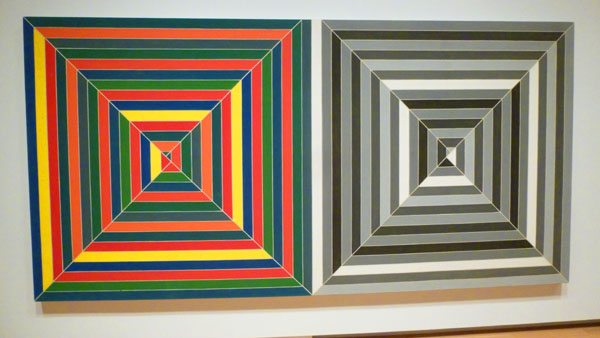 |
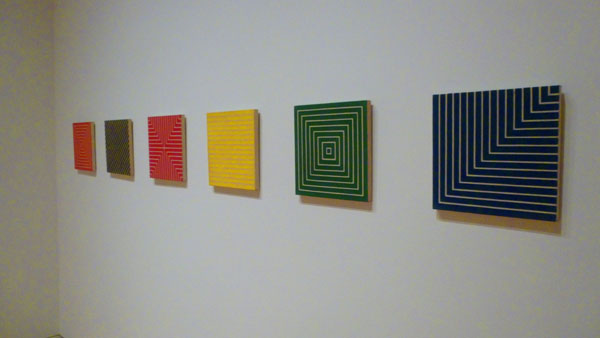 |
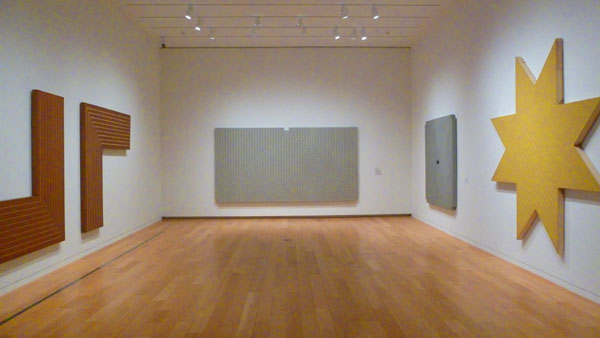 |
A couple of the installations were so massive that to get them all in one picture they'd be really small 'cause I'd be so far away. So for each of them, I took a series of 4 or 5 pictures closer up, then merged them together:
 |
 |
Leaving the galleries and walking back through the main lobby on our way to the cafe, I found one more art installation, although there was no sign around to tell me what it was all about. Maybe you can figure out what it is.
Lunch at the Modern Cafe
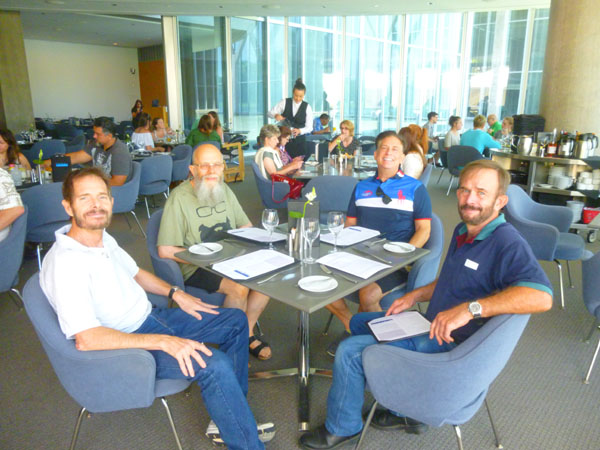 |
I also stepped away from the table to make this panoramic view of most of The Modern Cafe:
 |
After lunch, we went outside and headed down the block to the Kimbell Museum.
The Kimbell Museum
|
With the appointment in 1965 of Richard F. Brown, then director of the Los Angeles County Museum of Art, as the Museum’s first director, the Foundation began planning for the future museum and development of the collection, and developed a Statement of the future museum's purpose. In accordance with that policy, the Foundation acquires and retains works of so-called “definitive excellence”— works that may be said to define an artist or type regardless of medium, period, or school of origin. The aim of the Kimbell is not historical completeness but the acquisition of individual objects of “the highest possible aesthetic quality” as determined by condition, rarity, importance, suitability, and communicative powers. The rationale is that a single work of outstanding merit and significance is more effective as an educational tool than a larger number of representative examples.
Two aspects of the 1966 policy in particular would have the greatest impact on changing the Kimbell collection: an expansion of vision to encompass world history and a new focus on building through acquisition and refinement a small collection of key objects of surpassing quality. The Kimbell collection today consists of about 350 works that not only epitomize their periods and movements but also touch individual high points of aesthetic beauty and historical importance.
The most recent development was the opening two years ago of the Piano Pavilion, which houses special exhibitions as well as much of the Kimbell's permanent collection of sculpture.
|
This new Pavilion has not been open for perhaps five years now; Fred and I have been here twice to see special exhibits. “Close enough for a conversation, not too close and not too far away,” remarked architect Renzo Piano, when describing the distance from the Kimbell’s new Renzo Piano Pavilion to the Louis Kahn Building. Piano’s acknowledges Kahn’s museum building by way of its kindred height, emphasis on natural light, and use of concrete as a primary material. The positioning of the pavilion on the site focuses attention on the west facade of the Kahn Building, which Kahn considered to be the main entrance.
Renowned architect Renzo Piano has won the Pritzker Prize, the AIA Gold Medal, and other architectural awards, and he and his firm have designed skyscrapers, department stores, churches, factories, housing, university buildings, stadia, a winery and even a bridge. Born in 1937, Piano joined with Richard Rogers and Peter Rice to win the competition to design and build the Centre Georges Pompidou in Paris. Afteer designing a museum in Houston for Schlumberger oil-equipment heiress Dominique de Menil, a building hailed as a new milestone in museum architecture, Piano's firm has received a steady stream of museum commissions, including the Nasher Sculpture Center in Dallas.
The pavilion is made up of two sections connected by a glass passageway. The front section has galleries, the store and a spacious entrance lobby. Tucked under a green roof (it's not that the roof is colored green; it's that there is a lawn on top of the building, one that is accessible to pedestrians from the outside), the Piano Pavilion’s western section contains a gallery for light-sensitive works of art, three education studios, a large library with reading areas, and an auditorium with superior acoustics for music. The latter, located below ground level, is a design centerpiece: its raked seating faces the stage and the dramatic backdrop of a light well animated by shifting patterns of natural light.
Today, we spent out time in the Kahn building's main gallery, where an eclectic exhibition from the Museum's permanent collection was on display. These paintings and other artworks spanned the 16th, 17th and 18th centuries, and presented a wide range of styles and subject matter. I took pictures of many of the works, and also took pictures of most of their descriptions (as I wouldn't be able to remember them all). To show these pictures to you, I've created another slideshow. On each slide, I intended to pair my photo of a work with my photo of its description, but I found that a good many of the descriptions couldn't easily be read at the size I needed them for the slides, so I went ahead and transcribed them to the slides. As usual, you can go from slide to slide with the "backward" and "forward" arrows in the lower corners of each, and you can track your progress through the show with the numbers in the upper left of each slide.
Enjoy looking at these masterworks from the Kimbell Museum:
The only other pictures I took here at the Kimbell were of the interior atrium which is in the middle of the south gallery in the Kahn Building. It's main purpose is to allow natural light into the gallery.
|
As it turned out, there was a nice fountain in the atrium, but of course pictures of fountains don't tell the real story of what they're like, so you can watch the movie I made while we were out here:
|
The Atrium Fountain at the Kimbell (Mouseover Image Above for Video Controls) |
At Home with Rudolf
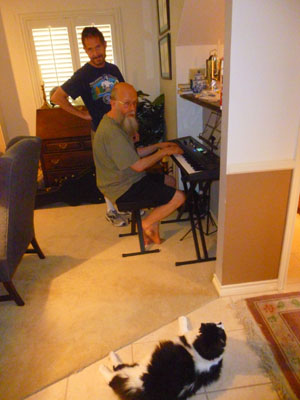 |
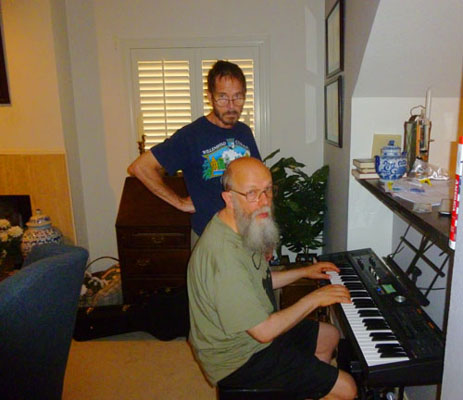 |
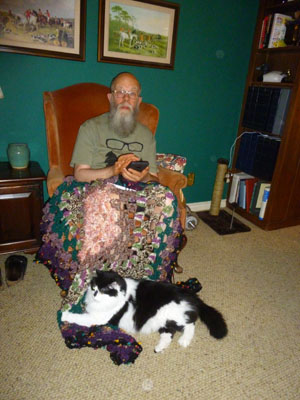 |
We enjoyed Rudolf's visit, as we always do, and hope that he will still be able to come visit us every few years.
You can use the links below to continue to another photo album page.
 |
August 18-21 & 26-28, 2016: At the Ruckmans' House in San Antonio |
 |
July 5, 2016: An Excursion on DART Light Rail |
 |
Return to the Index for 2016 |